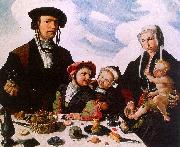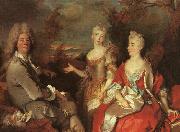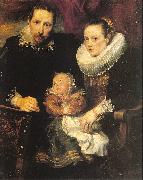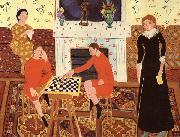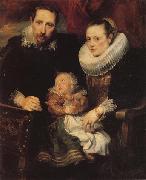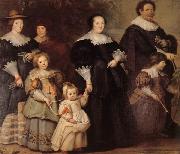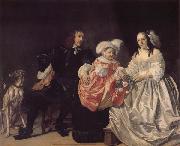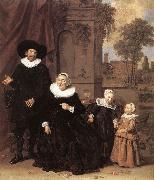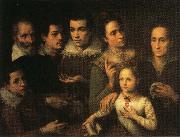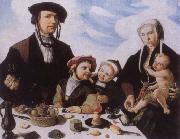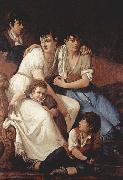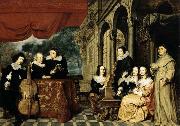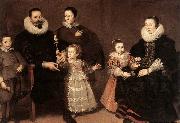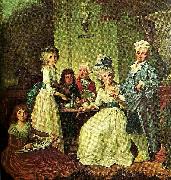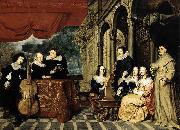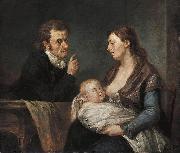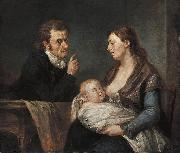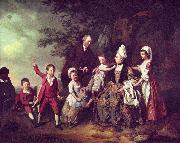Wholesale Oil Painting No Minimum |
|||||||||||
|
|
|||||||||||

|
|||||||||||
|
|
|
||||||||
Maerten Jacobsz van Heemskerck1498-1574 Flemish Maerten Jacobsz van Heemskerck Gallery |
||||||||
|
|
||||||||
Family Portrait
Family Portrait Painting ID:: 1621 |
1530
Staatliche Gemaldegalerie, Kassel 1530 Staatliche Gemaldegalerie, Kassel |
|||||||
|
|
||||||||
Nicolas de Largilliere1656-1746 French Nicolas de Largilliere Gallery Nicolas de Largilli??re (October 10, 1656 - March 20, 1746), French painter, was born in Paris. His father, a merchant, took him to Antwerp at the age of three. As a boy, he spent nearly two years in London. Sometime after his return to Antwerp, a failed attempt at business led him to the studio of Goubeau. However, Largilli??re left at the age of eighteen to seek his fortune in England, where he was befriended and employed by Lely, for four years at Windsor. His skills attracted Charles II, who wished to retain him in his service, but the fury aroused by the Rye House Plot against Roman Catholics alarmed Largilli??re. He left for Paris where he was well received by Le Brun and Van der Meulen. Despite his Flemish training as a portrait-painter, his reputation was soon established. Largilli??re's brilliant colour and lively touch attracted celebrities of his day??actresses, public men and popular preachers flocked to his studio. President Lambert, with his beautiful wife and daughter, were among his most noted subjects. |
||||||||
|
|
||||||||
|
|
Family Portrait
Family Portrait Painting ID:: 2352 |
1710
Musee du Louvre, Paris 1710 Musee du Louvre, Paris |
||||||
|
|
||||||||
Dyck, Anthony vanFlemish Baroque Era Painter, 1599-1641 Flemish painter and draughtsman, active also in Italy and England. He was the leading Flemish painter after Rubens in the first half of the 17th century and in the 18th century was often considered no less than his match. A number of van Dyck's studies in oil of characterful heads were included in Rubens's estate inventory in 1640, where they were distinguished neither in quality nor in purpose from those stocked by the older master. Although frustrated as a designer of tapestry and, with an almost solitary exception, as a deviser of palatial decoration, van Dyck succeeded brilliantly as an etcher. He was also skilled at organizing reproductive engravers in Antwerp to publish his works, in particular The Iconography (c. 1632-44), comprising scores of contemporary etched and engraved portraits, eventually numbering 100, by which election he revived the Renaissance tradition of promoting images of uomini illustri. His fame as a portrait painter in the cities of the southern Netherlands, as well as in London, Genoa, Rome and Palermo, has never been outshone; and from at least the early 18th century his full-length portraits were especially prized in Genoese, British and Flemish houses, |
||||||||
|
|
||||||||
|
|
Family Portrait
Family Portrait Painting ID:: 19014 |
1621
oil on canvas
The Hermitage, St. Petersburg 1621 oil on canvas The Hermitage, St. Petersburg |
||||||
|
|
||||||||
Henri MatisseFrench Fauvist Painter and Sculptor, 1869-1954 Henri Matisse is considered the most important French artist of the 20th century and, along with Pablo Picasso, one of the most influential modernist painters of the last century. Matisse began studying drawing and painting in the 1890s. A student of the masters of Post-Impressionism, Matisse later made a reputation for himself as the leader of a group of painters known as Les Fauves. An ironic label given to them by a critic, the name reflected Matisse's aggressive strokes and bold use of primary colors. In 1905 Matisse gained sudden fame with three paintings, including Woman with the Hat, purchased by the wealthy American ex-patriot Gertrude Stein. Beyond painting, he worked with lithographs and sculpture, and during World War II he did a series of book designs. Later in his career he experimented with paper cutouts and designed decorations for the Dominican chapel in Vence, France. Along with Picasso, |
||||||||
|
|
||||||||
|
|
Family Portrait
Family Portrait Painting ID:: 29281 |
mk65
1911
Oil on canvas
56x76"
mk65 1911 Oil on canvas 56x76" |
||||||
|
|
||||||||
Anthony Van DyckDutch 1599-1641 Anthony Van Dyck Locations Flemish painter and draughtsman, active also in Italy and England. He was the leading Flemish painter after Rubens in the first half of the 17th century and in the 18th century was often considered no less than his match. A number of van Dyck studies in oil of characterful heads were included in Rubens estate inventory in 1640, where they were distinguished neither in quality nor in purpose from those stocked by the older master. Although frustrated as a designer of tapestry and, with an almost solitary exception, as a deviser of palatial decoration, van Dyck succeeded brilliantly as an etcher. He was also skilled at organizing reproductive engravers in Antwerp to publish his works, in particular The Iconography (c. 1632-44), comprising scores of contemporary etched and engraved portraits, eventually numbering 100, by which election he revived the Renaissance tradition of promoting images of uomini illustri. His fame as a portrait painter in the cities of the southern Netherlands, as well as in London, Genoa, Rome and Palermo, has never been outshone; and from at least the early 18th century his full-length portraits were especially prized in Genoese, British and Flemish houses, where they were appreciated as much for their own sake as for the identities and families of the sitters. |
||||||||
|
|
||||||||
|
|
Family Portrait
Family Portrait Painting ID:: 29323 |
mk65
1621
Oil on canvas
44 1/2x37"
mk65 1621 Oil on canvas 44 1/2x37" |
||||||
|
|
||||||||
Cornelis de Vos1585-1651 Flemish Cornelis de Vos Gallery Flemish portrait and figure painter. He was a contemporary of Rubens, who sent many sitters to him. Although of the school of Rubens, Vos developed an individual style of portraiture in which cool grays predominate. His representations of children were particularly successful. An example of his many portraits is that of Abraham Grapheus (Antwerp). His brother, Paulus de Vos, c.1596?C1678, was an excellent painter of animals and hunting scenes. His paintings show the influence of his brother-in-law, Frans Snyders. His work is best seen in the museums of Madrid and St. Petersburg. |
||||||||
|
|
||||||||
|
|
Family Portrait
Family Portrait Painting ID:: 29329 |
mk65
Oil on canvas
73x87"
mk65 Oil on canvas 73x87" |
||||||
|
|
||||||||
Bartholomeus van der Helst1613-1670 Dutch Bartholomeus Van Der Helst Galleries Dutch painter. He was the son of a Haarlem inn-keeper and presumably undertook part or all of his training in Amsterdam. His earliest works suggest that the painter Nicolaes Eliasz. Pickenoy was his master. Although van der Helst had probably already established himself as an independent master by the time he married Anna du Pire in Amsterdam in 1636, his earliest known work, a portrait of The Regents of the Walloon Orphanage, Amsterdam (Amsterdam, Maison Descartes), dates from 1637. Stylistically it is close to the work of Pickenoy. His portrait of a Protestant Minister of 1638 (Rotterdam, Boymans-van Beuningen) reveals the influence of Rembrandt. The young artist must have risen rapidly to fame in Amsterdam, for as early as 1639 he received the prestigious commission for a large painting for the Kloveniersdoelen (Arquebusiers or Musketeers Hall): The Civic Guard Company of Capt. Roelof Bicker and Lt Jan Michielsz. Blaeuw (Amsterdam, Rijksmus.), which formed part of the same series as Rembrandt Night Watch (Amsterdam, Rijksmus.). Van der Helst may not have completed this commission until 1642 or 1643. The ingenious arrangement of the figures in a broad composition shows the artist special talent for composing large groups. Pickenoy influence is less noticeable here than in the portrait of 1637; the self-assured poses of the individual figures were to become a characteristic feature of van der Helst work. The successful execution of this portrait established van der Helst reputation: from 1642, when he began to receive an increasing number of commissions for individual portraits, until 1670 he was the leading portrait painter of the ruling class in Amsterdam. From 1642 his technique in portrait painting gradually became more fluent and the rendering of costume materials more detailed. Some typical portraits of his earlier period are those of Andries Bicker (Amsterdam, Rijksmus.), his wife Catharina Gansneb Tengnagel (Dresden, Gemeldegal. Alte Meister) and their son Gerard Bicker (Amsterdam, Rijksmus.), all of 1642, and the Portrait of a Young Girl (1645; London, N.G.). In 1648 van der Helst painted a second civic guard portrait, The Celebration of the Peace of M?nster at the Crossbowmen Headquarters, Amsterdam (Amsterdam, Rijksmus.), a superbly composed and well painted portrait that, until the late 19th century, was considered one of the masterpieces of the Golden Age but later lost popularity because of its smooth and modish execution. It can nevertheless still be regarded as one of the most important group portraits of the 17th century. Its technical perfection, characterized by a well-modelled rendering of the figures and a smooth handling of the brush, dominated the rest of van der Helst oeuvre. |
||||||||
|
|
||||||||
|
|
Family Portrait
Family Portrait Painting ID:: 29330 |
mk65
1652
Oil on canvas
74x89"
mk65 1652 Oil on canvas 74x89" |
||||||
|
|
||||||||
HALS, FransDutch painter (b. 1580, Antwerpen, d. 1666, Haarlem). |
||||||||
|
|
||||||||
|
|
Family Portrait
Family Portrait Painting ID:: 29594 |
c. 1635
Oil on canvas, 113 x 93,4 cm c. 1635 Oil on canvas, 113 x 93,4 cm |
||||||
|
|
||||||||
Lavinia FontanaItalian Painter, 1552-1614 Daughter of Prospero Fontana. She was trained by her father and followed his Mannerist style. Her first recorded works, which date from 1575, were small paintings for private devotion, such as the Holy Family (Dresden, Gemeldegal.). By 1577 she had become established as a portrait painter in Bologna. Works of this date include the Self-portrait at the Harpsichord (Rome, Gal. Accad. S Luca) and the portrait of Senator Orsini (Bordeaux, Mus. B.-A.). Her portrait style reflects the formality of central Italian models as well as the naturalistic tendencies of the north Italian tradition. The elegantly costumed Orsini is shown seated at a table, with a suite of rooms opening behind him, a setting recalling such Florentine portraits of the 1530s as Agnolo Bronzino's Bartolommeo Panciatichi (Florence, Uffizi). Lavinia used a similar setting for other portraits, including the Gozzadini Family (1584; Bologna, Pin. N.). Female sitters are also shown in elaborate dress, with particular attention paid to details of embroidery and jewels, and they are often accompanied by small dogs |
||||||||
|
|
||||||||
|
|
Family Portrait
Family Portrait Painting ID:: 30535 |
mk68
Oil on canva
33 1/2"x41 1/2"
Milan,Brera Gallery
c.1600
Italy
mk68 Oil on canva 33 1/2"x41 1/2" Milan,Brera Gallery c.1600 Italy |
||||||
|
|
||||||||
Maerten Jacobsz van Heemskerck1498-1574 Flemish Maerten Jacobsz van Heemskerck Gallery |
||||||||
|
|
||||||||
|
|
Family portrait
Family portrait Painting ID:: 40351 |
mk156
1532
Oil on panel
118x140cm
mk156 1532 Oil on panel 118x140cm |
||||||
|
|
||||||||
Francesco Hayez1791-1882 Italian Francesco Hayez Galleries Hayez came from a relatively poor family from Venice. His father was of French origin while his mother, Chiara Torcella, was from Murano. The child Francesco, youngest of five sons, was brought up by his mother sister, who had married Giovanni Binasco, a well-off shipowner and collector of art. From childhood he showed a predisposition for drawing, so his uncle apprenticed him to an art restorer. Later he became a student of the painter Francisco Magiotto with whom he continued his studies for three years. He was admitted to the painting course of the New Academy of Fine Arts in 1806, where he studied under Teodoro Matteini. In 1809 he won a competition from the Academy of Venice for one year of study at the Accademia di San Luca in Rome. He remained in Rome until 1814, then moved to Naples where he was commissioned by Joachim Murat to paint a major work depicting Ulysses at the court of Alcinous. In the mid 1830s he attended the Salotto Maffei salon in Milan, hosted by Clara Maffei (whose portrait Hayez painted for her husband), and he was still in Milan in 1850 when he was appointed director of the Academy of Brera there. Assessment of the career of Hayez is complicated by the fact that he often did not sign or date his works. Often the date indicated from the evidence is that at which the work was acquired or sold, not of its creation. Moreover he often painted the same compositions several times with minimal variations, or even with no variation. His early works show the influence of Ingres and the Nazarene movement. His later work participates in the Classical revival. |
||||||||
|
|
||||||||
|
|
Family Portrait
Family Portrait Painting ID:: 59259 |
Family Portrait (1807)
Museo Luigi Bailo, Treviso
Family Portrait (1807) Museo Luigi Bailo, Treviso |
||||||
|
|
||||||||
Gonzales Coques1615 - 1684 was a Flemish Baroque painter He was the son of Pieter Willemsen Coques, a respectable Flemish citizen, and not, as his name might imply, a Spaniard, was born in Antwerp. In 1626?C28 he entered the studio of Pieter Brueghel the Younger, and subsequently studied with David II Rijckaert.He is primarily known as a painter of small cabinet conversation pieces, a type of elegant informal group portrait that he is credited with inventing. The influence of Anthony van Dyck resulted in his nickname "Little van Dyck". After a period of travel, probably to England where Van Dyck was active, he entered Antwerp's Guild of St. Luke in 1640?C41. He was married twice, first to Ryckaert's daughter Catharina, and then to Catharina Rysheuvels. He was a member of two rhetorician guilds in the city, and twice he was made president of the painters' guild. This small portraits were in great demand with both the bourgeoisie and nobility.Patrons included Frederick William, Elector of Brandenburg, Frederick Henry, Prince of Orange and John of Austria the Younger. One of his canvases in the gallery at the Hague represents a suite of rooms hung with pictures, in which the artist himself may be seen at a table with his wife and two children, surrounded by masterpieces composed and signed by several contemporaries. Partnership in painting was common amongst the small masters of the Antwerp school; and it has been truly said of Coques that he employed Jacob von Arthois for landscapes, Anton Ghering and Willem Schubart von Ehrenberg for architectural backgrounds, Hendrik Steenwijck the younger for interiors, and Pieter Gysels for still life and flowers; but the model upon which Coques formed himself was Van Dyck, |
||||||||
|
|
||||||||
|
|
Family Portrait
Family Portrait Painting ID:: 62366 |
65,5 x 89,5 cm Museum of Fine Arts, Budapest The painting presumably shows Jacques van Eyck, the chief justice of Antwerp in the bosom of his family. They gather on the terrace of their palace. The painting is relatively small but is provided with some essential attributes of the representative Baroque portrait 65,5 x 89,5 cm Museum of Fine Arts, Budapest The painting presumably shows Jacques van Eyck, the chief justice of Antwerp in the bosom of his family. They gather on the terrace of their palace. The painting is relatively small but is provided with some essential attributes of the representative Baroque portrait |
||||||
|
|
||||||||
VOS, Cornelis deFlemish painter (b. 1584/85, Hulst, d. 1651, Antwerpen) Flemish portrait and figure painter. He was a contemporary of Rubens, who sent many sitters to him. Although of the school of Rubens, Vos developed an individual style of portraiture in which cool grays predominate. His representations of children were particularly successful. An example of his many portraits is that of Abraham Grapheus (Antwerp). His brother, Paulus de Vos, c.1596 C1678, was an excellent painter of animals and hunting scenes. His paintings show the influence of his brother-in-law, Frans Snyders. |
||||||||
|
|
||||||||
|
|
Family Portrait
Family Portrait Painting ID:: 64185 |
1631 Oil on panel, 165 x 135 cm Koninklijk Museum voor Schone Kunsten, Antwerp Portraiture was generally viewed as a slightly inferior branch of art, as it required less inventiveness on the part of the painter. The portraits of Cornelis De Vos, who was born in Hulst in the Northern Netherlands, but who was active in Antwerp, are amongst the most beautiful produced in the Southern Netherlands in the 17th century. The full-length, life-size subjects of his Family Portrait are executed in a truthful and intriguing manner. , Artist: VOS, Cornelis de , Family Portrait , 1601-1650 , Flemish , painting , portrait 1631 Oil on panel, 165 x 135 cm Koninklijk Museum voor Schone Kunsten, Antwerp Portraiture was generally viewed as a slightly inferior branch of art, as it required less inventiveness on the part of the painter. The portraits of Cornelis De Vos, who was born in Hulst in the Northern Netherlands, but who was active in Antwerp, are amongst the most beautiful produced in the Southern Netherlands in the 17th century. The full-length, life-size subjects of his Family Portrait are executed in a truthful and intriguing manner. , Artist: VOS, Cornelis de , Family Portrait , 1601-1650 , Flemish , painting , portrait |
||||||
|
|
||||||||
naigeon(July 15 1738, Paris - 28 February 1810, Paris) was a French artist, atheist philosopher, editor and man of letters best known for his contributions to the Encyclop??die and for reworking Baron d'Holbach's and Diderot's manuscripts. |
||||||||
|
|
||||||||
|
|
family portrait
family portrait Painting ID:: 64388 |
1793
collection r. w. 1793 collection r. w. |
||||||
|
|
||||||||
Gonzales Coques1615 - 1684 was a Flemish Baroque painter He was the son of Pieter Willemsen Coques, a respectable Flemish citizen, and not, as his name might imply, a Spaniard, was born in Antwerp. In 1626?C28 he entered the studio of Pieter Brueghel the Younger, and subsequently studied with David II Rijckaert.He is primarily known as a painter of small cabinet conversation pieces, a type of elegant informal group portrait that he is credited with inventing. The influence of Anthony van Dyck resulted in his nickname "Little van Dyck". After a period of travel, probably to England where Van Dyck was active, he entered Antwerp's Guild of St. Luke in 1640?C41. He was married twice, first to Ryckaert's daughter Catharina, and then to Catharina Rysheuvels. He was a member of two rhetorician guilds in the city, and twice he was made president of the painters' guild. This small portraits were in great demand with both the bourgeoisie and nobility.Patrons included Frederick William, Elector of Brandenburg, Frederick Henry, Prince of Orange and John of Austria the Younger. One of his canvases in the gallery at the Hague represents a suite of rooms hung with pictures, in which the artist himself may be seen at a table with his wife and two children, surrounded by masterpieces composed and signed by several contemporaries. Partnership in painting was common amongst the small masters of the Antwerp school; and it has been truly said of Coques that he employed Jacob von Arthois for landscapes, Anton Ghering and Willem Schubart von Ehrenberg for architectural backgrounds, Hendrik Steenwijck the younger for interiors, and Pieter Gysels for still life and flowers; but the model upon which Coques formed himself was Van Dyck, |
||||||||
|
|
||||||||
|
|
Family Portrait
Family Portrait Painting ID:: 75433 |
1650s
Oil on panel
89.5 cm (35.2 in). Height: 65.5 cm (25.8 in).
cjr 1650s Oil on panel 89.5 cm (35.2 in). Height: 65.5 cm (25.8 in). cjr |
||||||
|
|
||||||||
Gonzales Coques1615 - 1684 was a Flemish Baroque painter He was the son of Pieter Willemsen Coques, a respectable Flemish citizen, and not, as his name might imply, a Spaniard, was born in Antwerp. In 1626?C28 he entered the studio of Pieter Brueghel the Younger, and subsequently studied with David II Rijckaert.He is primarily known as a painter of small cabinet conversation pieces, a type of elegant informal group portrait that he is credited with inventing. The influence of Anthony van Dyck resulted in his nickname "Little van Dyck". After a period of travel, probably to England where Van Dyck was active, he entered Antwerp's Guild of St. Luke in 1640?C41. He was married twice, first to Ryckaert's daughter Catharina, and then to Catharina Rysheuvels. He was a member of two rhetorician guilds in the city, and twice he was made president of the painters' guild. This small portraits were in great demand with both the bourgeoisie and nobility.Patrons included Frederick William, Elector of Brandenburg, Frederick Henry, Prince of Orange and John of Austria the Younger. One of his canvases in the gallery at the Hague represents a suite of rooms hung with pictures, in which the artist himself may be seen at a table with his wife and two children, surrounded by masterpieces composed and signed by several contemporaries. Partnership in painting was common amongst the small masters of the Antwerp school; and it has been truly said of Coques that he employed Jacob von Arthois for landscapes, Anton Ghering and Willem Schubart von Ehrenberg for architectural backgrounds, Hendrik Steenwijck the younger for interiors, and Pieter Gysels for still life and flowers; but the model upon which Coques formed himself was Van Dyck, |
||||||||
|
|
||||||||
|
|
Family Portrait
Family Portrait Painting ID:: 77282 |
Date 1650s
Medium Oil on panel
cyf Date 1650s Medium Oil on panel cyf |
||||||
|
|
||||||||
Johann Georg Edlingerpainted Family Portrait in 1800 |
||||||||
|
|
||||||||
|
|
Family Portrait
Family Portrait Painting ID:: 84519 |
Date ca. 1800(1800)
Medium Oil on oak
Dimensions Height: 94 cm (37 in). Width: 110 cm (43.3 in).
cjr Date ca. 1800(1800) Medium Oil on oak Dimensions Height: 94 cm (37 in). Width: 110 cm (43.3 in). cjr |
||||||
|
|
||||||||
Maarten van Heemskerck(1498 - 1 October 1574) was a Dutch portrait and religious painter, known for his depictions of the Seven Wonders of the World. He was born at Heemskerk, North Holland, halfway between Alkmaar and Haarlem. His father was a small farmer, Jacob Willemsz. van Veen (whose portrait he painted). According to his biography, written by Karel van Mander, he was apprenticed to Cornelis Willemsz in Haarlem. Recalled after a time to the paternal homestead and put to the plough or the milking of cows, young Heemskerk took the first opportunity that offered to run away, and demonstrated his wish to leave home for ever by walking in a single day the 80 km which separate his native hamlet from the town of Delft. There he studied under Jan Lucasz whom he soon deserted for his contemporary Jan van Scorel of Haarlem. Even today, many of Heemskerck's paintings are mistaken for work by van Scorel. He boarded at the home of the wealthy Pieter Jan Foppesz (the van Mander spelling is Pieter Ian Fopsen), curate of the Sint-Bavokerk. He knew him because he owned a lot of land in Heemskerck. This is the same man whom he painted in a now famous family portrait, considered the first of its kind in a long line of Dutch family paintings. |
||||||||
|
|
||||||||
|
|
Family Portrait
Family Portrait Painting ID:: 86844 |
Date c. 1530(1530)
Medium Oil on wood
Dimensions Height: 118 cm (46.5 in). Width: 140 cm (55.1 in).
cjr Date c. 1530(1530) Medium Oil on wood Dimensions Height: 118 cm (46.5 in). Width: 140 cm (55.1 in). cjr |
||||||
|
|
||||||||
Johann Georg Edlingerpainted Family Portrait in 1800 |
||||||||
|
|
||||||||
|
|
Family Portrait
Family Portrait Painting ID:: 88369 |
1800(1800)
Medium Oil on oak
cyf 1800(1800) Medium Oil on oak cyf |
||||||
|
|
||||||||
Maarten van Heemskerck(1498 - 1 October 1574) was a Dutch portrait and religious painter, known for his depictions of the Seven Wonders of the World. He was born at Heemskerk, North Holland, halfway between Alkmaar and Haarlem. His father was a small farmer, Jacob Willemsz. van Veen (whose portrait he painted). According to his biography, written by Karel van Mander, he was apprenticed to Cornelis Willemsz in Haarlem. Recalled after a time to the paternal homestead and put to the plough or the milking of cows, young Heemskerk took the first opportunity that offered to run away, and demonstrated his wish to leave home for ever by walking in a single day the 80 km which separate his native hamlet from the town of Delft. There he studied under Jan Lucasz whom he soon deserted for his contemporary Jan van Scorel of Haarlem. Even today, many of Heemskerck's paintings are mistaken for work by van Scorel. He boarded at the home of the wealthy Pieter Jan Foppesz (the van Mander spelling is Pieter Ian Fopsen), curate of the Sint-Bavokerk. He knew him because he owned a lot of land in Heemskerck. This is the same man whom he painted in a now famous family portrait, considered the first of its kind in a long line of Dutch family paintings. |
||||||||
|
|
||||||||
|
|
Family Portrait
Family Portrait Painting ID:: 91654 |
1530(1530)
Medium oil on panel
Dimensions Height: 118 cm (46.5 in). Width: 140 cm (55.1 in
cyf 1530(1530) Medium oil on panel Dimensions Height: 118 cm (46.5 in). Width: 140 cm (55.1 in cyf |
||||||
|
|
||||||||
Johann ZoffanyGerman (Resident in Britain) 1734-1810 Johann Zoffany Galleries Painter of portraits, conversation pieces, and theatrical scenes, Zoffany was born in Germany and came to England about 1758 after studying in Italy. He began by painting clock faces and doing hack work, before turning to painting theatrical scenes, especially depicting David Garrick. He was favoured by the royal family. George III nominated him for the Royal Academy in 1769 and recommended him to the duke of Tuscany. |
||||||||
|
|
||||||||
|
|
Family Portrait
Family Portrait Painting ID:: 95423 |
Date circa 1775(1775)
Medium oil on canvas
Dimensions 102 x 126.5 cm (40.2 x 49.8 in)
TTD Date circa 1775(1775) Medium oil on canvas Dimensions 102 x 126.5 cm (40.2 x 49.8 in) TTD |
||||||
|
|
||||||||
|
Johann Zoffany German (Resident in Britain) 1734-1810 Johann Zoffany Galleries Painter of portraits, conversation pieces, and theatrical scenes, Zoffany was born in Germany and came to England about 1758 after studying in Italy. He began by painting clock faces and doing hack work, before turning to painting theatrical scenes, especially depicting David Garrick. He was favoured by the royal family. George III nominated him for the Royal Academy in 1769 and recommended him to the duke of Tuscany. Family Portrait Date circa 1775(1775) Medium oil on canvas Dimensions 102 x 126.5 cm (40.2 x 49.8 in) TTD |
||||||||
|
|
||||||||
|
Prev Next
|
||||||||
|
|
||||||||
|
Related Paintings to Johann Zoffany :. |
||||||||
|
|
||||||||
|
CONTACT US |
